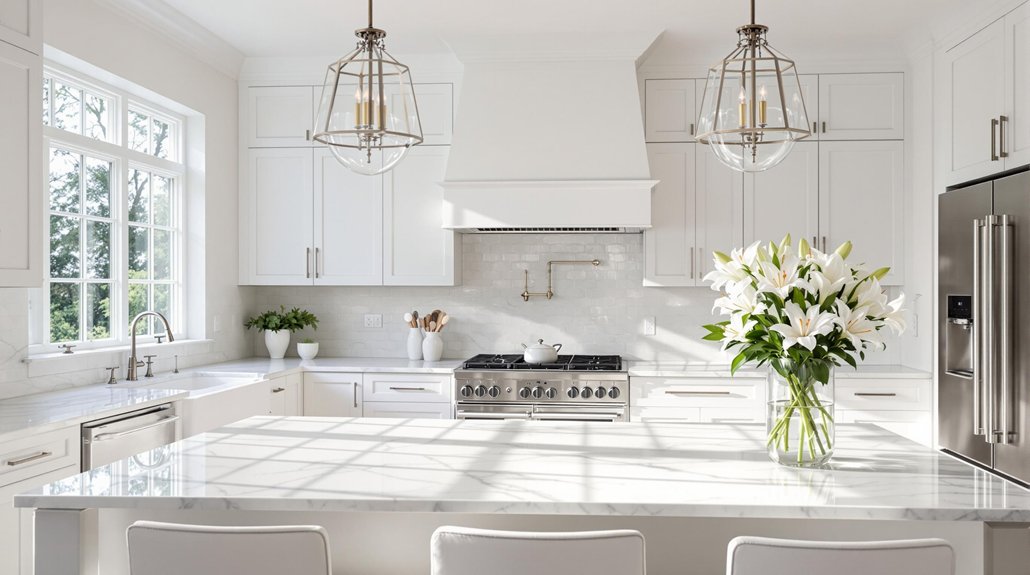
22 White Kitchen Ideas That Are Bright, Timeless, and Beautiful
White kitchens capture enduring appeal through crisp palettes, luminous cabinetry, and inventive design choices. Experts recommend all-white aesthetics for a seamless look, or pairing white with dramatic dark cupboards for visual layering. Incorporating open shelving, tactile woods, and geometric patterned flooring keeps spaces both sophisticated and practical. Pops of color, like sunny yellow or brass fixtures, add dimension while off-white finishes offer ease of maintenance. Discover how modern textures, bold backsplashes, and curated accents further enhance these timeless kitchens.
Key Takeaways
- Embrace an all-white kitchen aesthetic for a timeless, bright space that acts as a versatile canvas for seasonal and personal style updates.
- Incorporate contrasting lower cabinets or wood flooring to add depth, warmth, and visual interest while maintaining a light and airy feel.
- Use standout backsplashes or patterned flooring to introduce texture and create striking focal points without overwhelming the white palette.
- Add open shelving or a breakfast bar to enhance functionality and visual lightness, perfect for compact or modern kitchens.
- Accentuate with brass fixtures, yellow decor, or colorful accessories to infuse personality and warmth into your white kitchen design.
Choose Open Shelving
Embrace the visual lightness of open shelving to transform white kitchens into bright, accessible spaces. Open shelving, particularly when painted in the same crisp shade as the walls, amplifies natural light and fosters an uncluttered, cohesive aesthetic.
This approach is especially advantageous in compact or galley-style white kitchens, where maximizing both utility and spaciousness is essential. Floating shelves invite curated displays of minimalist white crockery and select decorative objects, functioning as both practical storage and a dynamic visual feature.
Create a Contemporary Vision With All-White
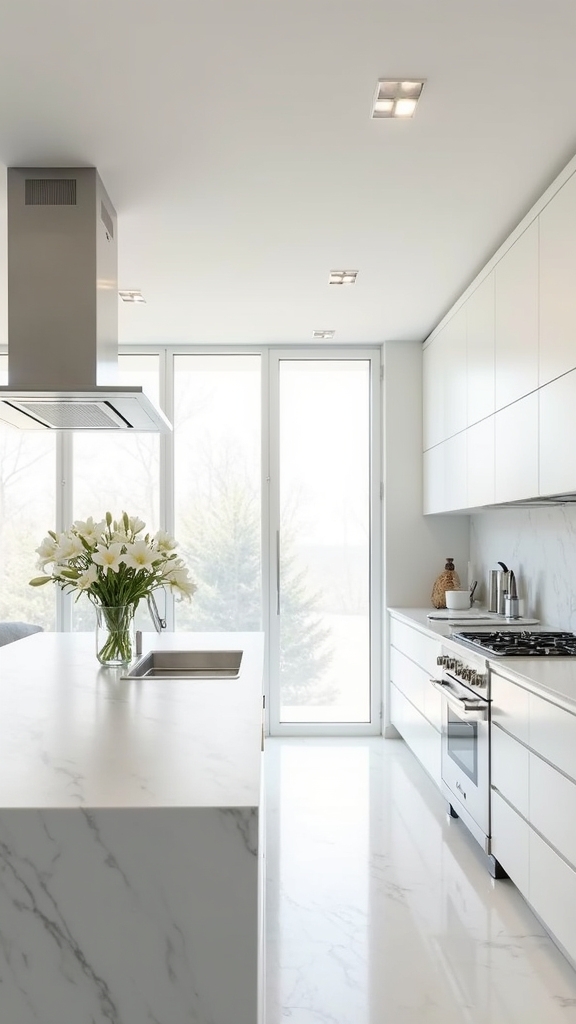
A truly contemporary kitchen often finds its expression in the all-white aesthetic, where every surface—from cabinetry and countertops to walls and appliances—aligns in a monochromatic palette.
The all-white kitchen achieves a seamless, cohesive look that amplifies natural and artificial light, making even modest spaces feel expansive and luminous. Expertly chosen chrome handles introduce restrained metallic accents, punctuating the pristine backdrop without detracting from the overall unity.
This approach is especially favored in modern design for its versatility: the all-white scheme acts as a blank canvas, allowing for seasonal or personal pops of color through accessories or artwork.
The enduring popularity of the all-white kitchen lies in its ability to remain fresh and relevant, exemplifying a timeless vision that continues to define contemporary kitchen design.
Add Interest With a Patterned Floor
Introducing geometric tile patterns on the floor injects striking visual energy into a white kitchen, instantly drawing the eye and defining the space.
The interplay of bold motifs with neutral cabinetry and surfaces maintains a harmonious balance, preventing the scheme from feeling clinical.
This approach reflects current design trends favoring graphic interest while preserving the kitchen’s timeless, understated elegance.
Geometric Tile Visual Impact
While white kitchens evoke a sense of timeless sophistication, integrating geometric tile patterns on the floor can dramatically boost visual intrigue. Geometric tiles—such as chevron, herringbone, or hexagonal motifs—introduce movement and depth, transforming a monochromatic space into a dynamic environment. These tiles serve as a striking focal point, balancing the crisp minimalism of a white kitchen while maintaining harmony through subtle, complementary hues or textured finishes. Opting for such patterns not only enhances aesthetic appeal but also offers practical benefits, as intricate designs can effectively obscure everyday wear and minor spills in high-traffic zones. The result is a kitchen that is both visually engaging and highly functional.
| Emotion | Design Element |
|---|---|
| Excitement | Bold hexagonal tiles |
| Calm | Muted geometric lines |
| Joy | Playful zig-zags |
| Inspiration | Artful floor mosaics |
| Satisfaction | Effortless upkeep |
Balance With Neutral Elements
Building upon the visual momentum established by geometric flooring, the strategic use of patterned floors paired with neutral elements enhances a white kitchen’s sophistication.
Patterned flooring—such as subtle zig-zag tiles—introduces dimension and movement, providing a dynamic counterpoint to the crisp lines of white cabinetry. Design professionals increasingly favor this approach as it breaks up the expanse of white without disrupting the palette’s serenity.
Choosing floor designs with muted tones preserves cohesion, while the intricate patterning injects understated drama. Incorporating natural wood finishes on islands or accent furniture further grounds the scheme, offering warmth and an organic touch.
The interplay between textured flooring and sleek white cabinetry results in a harmonious, contemporary kitchen that feels both visually engaging and inviting, epitomizing a balanced, timeless aesthetic.
Choose a Standout Backsplash
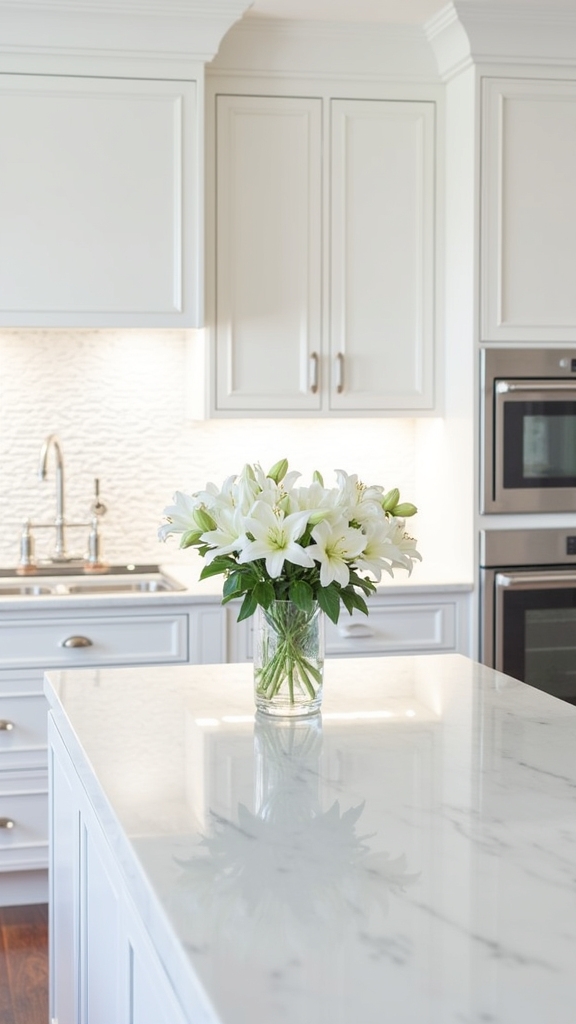
When seeking to enhance a white kitchen, a standout backsplash delivers both visual intrigue and practical value. A well-chosen backsplash introduces color and texture, breaking up the homogeneity of white cabinetry and surfaces. Current trends favor subtle hues such as pale pink, which provide a sophisticated accent without overpowering the light palette. For those aiming to increase visual interest, textured tiles or unique patterns create a striking focal point and boost the room’s design profile. Beyond aesthetics, a backsplash serves a functional role, shielding walls from splashes and stains during meal preparation. Opting for a colorful or patterned backsplash also offers an affordable opportunity to infuse personality, allowing for updates that refresh the kitchen’s look without major renovation expenses. Additionally, incorporating decorative window grilles adds elegance and allows natural light to filter through, enhancing the overall aesthetic.
Divide the Colour Scheme
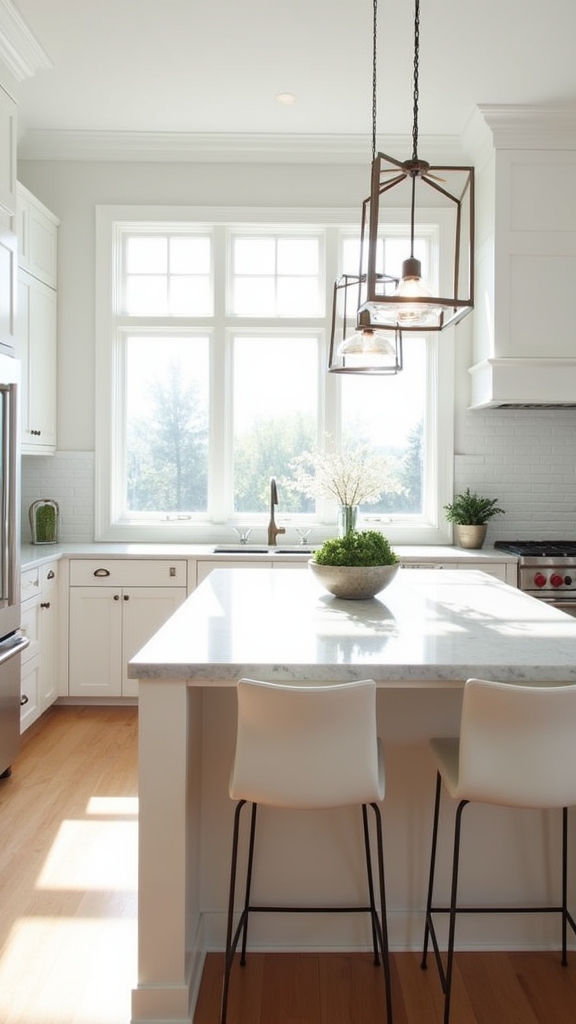
A divided color scheme—featuring crisp white upper cabinetry contrasted with rich, dark lower cupboards—creates dynamic visual layering and prevents a heavy atmosphere in compact kitchens. This balanced pairing, often complemented by walnut wood flooring, introduces depth while retaining a bright, airy ambiance. Contrasting cabinet finishes allow for sophisticated personalization, aligning with current trends for tailored, yet timeless, kitchen spaces. Incorporating greige cabinets enhances rustic charm and seamlessly blends with various design styles, ensuring a timeless appeal.
Upper White, Lower Dark
Upper cabinetry finished in crisp white, paired with lower units in a deep gunmetal grey, delivers a visually dynamic kitchen that balances lightness with depth.
This divided color scheme leverages the reflective qualities of white cabinets to amplify natural light and create an airy ambiance. In contrast, the dark cabinetry below grounds the space, introducing sophisticated contrast without overwhelming the room—an essential consideration in compact layouts.
Walnut wood flooring further anchors the design, infusing warmth and tactile interest that harmonizes with both finishes.
The juxtaposition of white upper and dark lower cabinets enhances spatial perception, giving the kitchen greater dimension and movement. This approach remains a contemporary favorite, offering a modern interpretation of classic cabinetry while ensuring enduring visual appeal and design versatility.
Contrasting Cabinet Finishes
By strategically dividing the color scheme between white upper cabinets and darker lower units, designers achieve a deliberate interplay of light and depth that defines contemporary kitchen aesthetics.
Contrasting finishes, such as pairing crisp white cabinets above with gunmetal grey or deep navy bases, lend definition and sophistication without overwhelming compact spaces. This method leverages the reflective quality of white to brighten the room, while grounding the design through bold, darker tones.
Walnut wood flooring can further enhance this effect, providing a tactile, organic anchor. Contrasting cabinet finishes not only raise visual interest but also assist in demarcating zones within open-plan layouts.
- Enhances spatial perception and depth
- Prevents visual monotony
- Grounds the kitchen with darker elements
- Maintains an airy, inviting atmosphere
- Defines functional zones through color differentiation
Balanced Color Pairings
Building on the visual intrigue of contrasting cabinet finishes, balanced color pairings employ a divided scheme, where crisp white upper walls are juxtaposed with darker lower cabinets to achieve both depth and cohesion.
This approach to the white colour scheme is especially effective in maximizing perceived space in compact kitchens—white elements reflect light, creating an airy ambiance, while grounded hues like gunmetal grey on base cabinets introduce visual weight and sophistication.
Walnut wood flooring acts as a unifying anchor, warming the palette and bridging the tonal divide.
The balanced aesthetic achieved through this method not only aligns with contemporary design trends but also offers flexibility for personal expression.
Strategic color distribution guarantees the kitchen remains inviting, uncluttered, and visually engaging without sacrificing functionality or style.
Keep the Look Bright and Airy
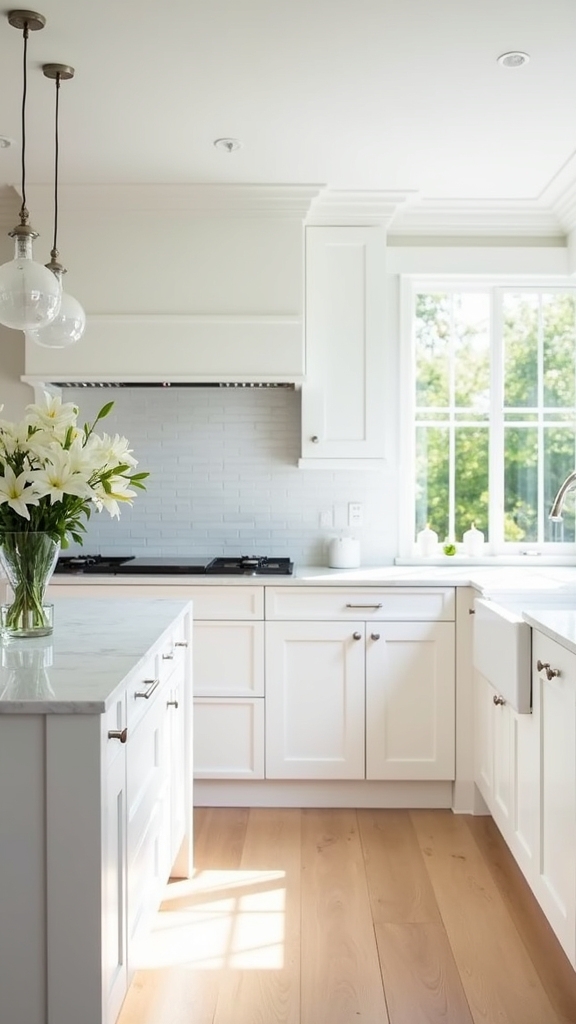
Although natural light is often considered the gold standard for kitchen illumination, the strategic use of white cabinetry and surfaces can dramatically amplify brightness, transforming even dimly lit spaces into expansive, inviting environments.
White cabinetry and surfaces can turn even the darkest kitchens into bright, open, and welcoming spaces.
Designers recommend layering white elements throughout the kitchen to cultivate a bright, airy ambiance that feels both timeless and contemporary. By integrating reflective finishes and optimizing the spatial arrangement, the kitchen’s openness is enhanced, reflecting current trends in minimalist and functional design.
To maintain this effect, consider the following expert strategies:
- Install skylights or use robust overhead lighting to highlight white surfaces.
- Choose open shelving painted to match the walls for seamless continuity.
- Opt for light-colored flooring, such as pale wood or tile, to further brighten the area.
- Select cabinetry with high-gloss finishes for maximum light reflection.
- Prioritize streamlined storage to avoid visual clutter and preserve airiness.
Mix Old With New for an Eclectic Finish

When vintage details are juxtaposed with contemporary white cabinetry, the resulting interplay infuses the kitchen with an eclectic character that feels curated rather than contrived.
Retro light fixtures suspended above a modern workspace bring a nostalgic narrative, while industrial accents—such as open metal shelving or exposed brick—lend a cutting-edge, urban sensibility to the classic white kitchen palette.
The strategic use of mixed textures, like glossy modern cabinets paired with rustic wooden countertops, enhances tactile interest and dimensionality.
Incorporating antique and modern accessories—think vibrant plates or curated artwork—injects warmth and individualized style.
To prevent visual chaos, design experts recommend anchoring the scheme with a cohesive color story, ensuring that the dialogue between old and new elements remains harmonious, sophisticated, and distinctly modern.
Take a Tonal Approach

A tonal approach expertly layers subtle greys with crisp whites, resulting in a refined yet inviting kitchen palette.
Integrating warm neutrals such as taupe balances the cooler spectrum, infusing the space with depth and comfort.
This nuanced use of color supports a cohesive environment where cabinetry, countertops, and finishes achieve visual equilibrium.
Layering Greys With White
By integrating nuanced greys with crisp white cabinetry, designers achieve a sophisticated tonal palette that brings both depth and cohesion to the kitchen environment.
The interplay of layering greys with white enhances the aesthetic, introducing subtle gradations that enrich visual interest while preserving a sense of airiness.
Utilizing tonal colours—from soft dove to bold charcoal—ensures the kitchen remains contemporary, yet timeless. This tonal approach enhances flexibility, enabling bold or minimalist accessorizing without clashing undertones.
Key design strategies include:
- Utilizing pale grey backsplashes to bridge white cabinetry and countertops
- Incorporating charcoal flooring for grounding contrast
- Selecting off-white walls to soften shifts between grey accents
- Introducing matte grey hardware for understated elegance
- Layering textured grey textiles for a tactile, cohesive finish
Warm Neutrals for Balance
Though white kitchens exude timeless appeal, infusing warm neutrals such as taupe and beige achieves a sophisticated balance, softening the starkness often associated with all-white schemes.
A tonal approach, blending warm neutrals with white cabinetry, enhances visual cohesion and fosters an inviting atmosphere. Subtle gradations—ranging from creamy beiges to pale taupes—integrate seamlessly with the clean lines of white cabinetry, offering understated elegance.
Layering these hues with carefully selected accessories, such as natural fiber textiles or warm-toned decor, prevents the space from feeling clinical. This curated palette guarantees a harmonious flow between design elements, while maintaining the luminous, airy qualities of a white kitchen.
The result is a unified, contemporary look that feels both comfortable and refined, in line with current design sensibilities.
Integrate an Alternative Island
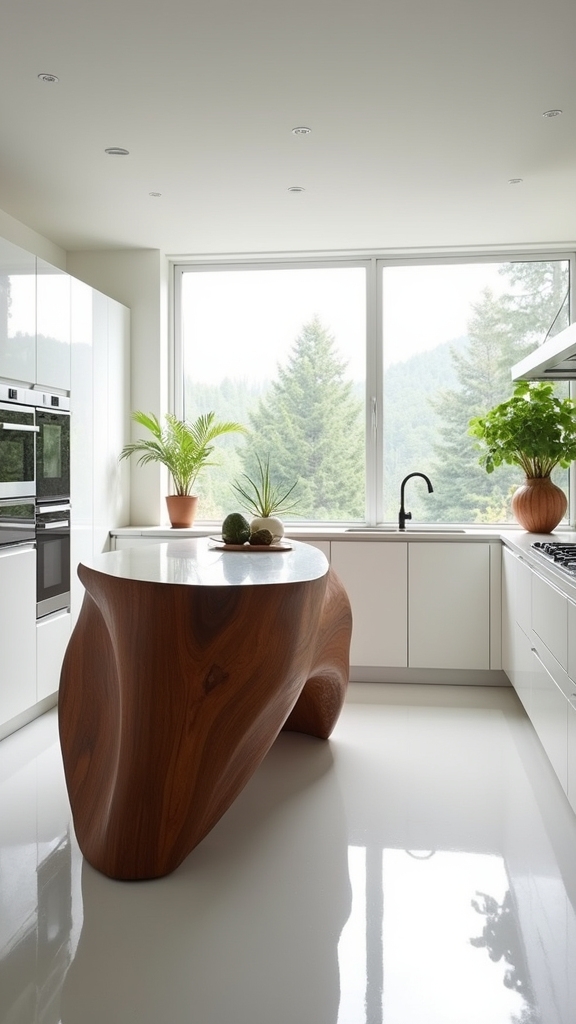
While an all-white kitchen epitomizes cleanliness and sophistication, integrating an alternative island—such as one crafted from natural wood—introduces a layer of visual depth and warmth that offsets the room’s monochromatic foundation.
Designers increasingly specify kitchen islands in contrasting materials or finishes to add warmth and create a compelling focal point. This approach not only enhances spatial dynamics but also boosts functionality and storage.
Thoughtful island selection can highlight architectural elements and offer tactile contrast to sleek white cabinetry. The interplay between crisp white surfaces and organic textures feels both modern and enduring.
- Contrasting wood or colored kitchen islands define the space and prevent visual monotony.
- Integrated open shelving maximizes utility and maintains a light, uncluttered appearance.
- Additional prep surfaces boost workflow efficiency.
- Complementary materials guarantee a cohesive, timeless aesthetic.
- Natural wood tones subtly add warmth and sophistication.
- Double kitchen islands significantly increase counter space for simultaneous dish prep, enhancing meal prep efficiency.
Choose White for a Timeless Country Look

Pairing an alternative island with crisp white cabinetry sets the stage for a kitchen that feels both inviting and enduring. White cabinetry, a hallmark of the traditional country kitchen, offers a versatile and luminous foundation that enhances natural light and creates visual expansiveness. Rustic wood accents—whether in the form of exposed beams or plank countertops—balance the brightness, introducing tactile warmth. Thoughtfully selected vintage hardware, such as wrought iron pulls, further raises the country motif. Classic white subway tile backsplashes underscore the timelessness, while open shelving showcases curated collections of rustic pottery or glassware. The interplay of these expert-approved elements crafts a harmonious space rooted in both heritage and contemporary appeal. Moreover, light greige tones can be introduced to foster a calming and inviting environment, enhancing the overall mood and atmosphere of the kitchen.
| Feature | Purpose | Visual Impact |
|---|---|---|
| White Cabinetry | Timeless Base | Airy, Expansive |
| Rustic Wood Elements | Warmth/Texture | Inviting, Earthy |
| Open Shelving | Display/Function | Personalized, Homey |
Warm up White With Brass Fixtures and Fittings
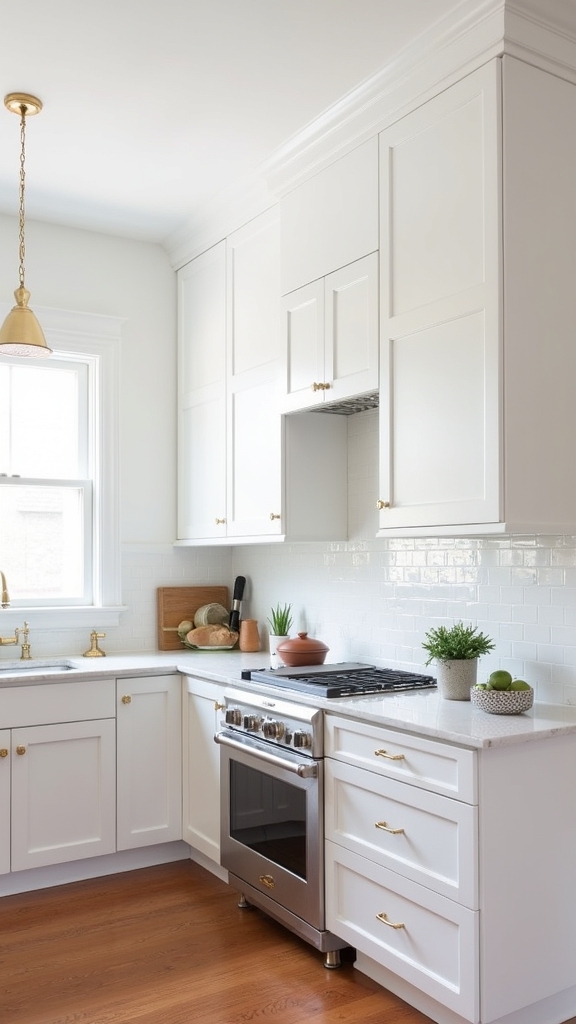
Incorporating brass fixtures and fittings into a white kitchen introduces a sophisticated layer of warmth and refinement, elevating the classic appeal of crisp cabinetry.
The interplay of lustrous brass handles against pristine white surfaces offers an inviting contrast, infusing luxury and vintage charm in equal measure. This combination not only reflects ambient light, enhancing the kitchen’s brightness, but also reinforces a timeless appeal that transcends fleeting trends.
Experts note that the versatility of brass allows it to seamlessly complement both modern minimalism and traditional aesthetics.
To maximize impact:
- Choose brushed or polished brass handles for cabinetry.
- Install brass faucets as a statement piece.
- Accent with brass light fixtures for cohesive elegance.
- Pair with marble or quartz for textural depth.
- Maintain brass with regular polishing to preserve shine.
Stick to a Classic Monochrome Combo
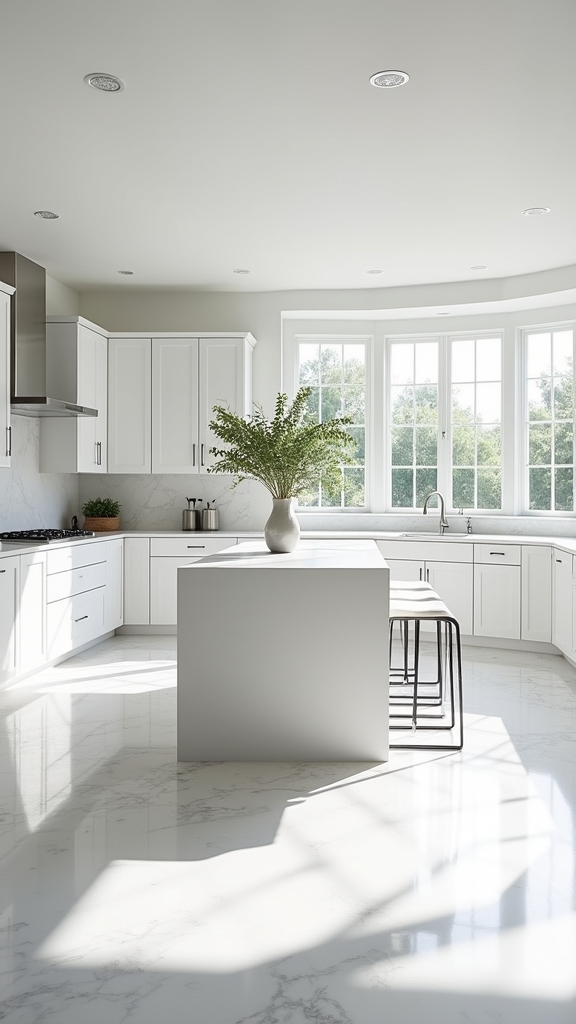
A black and white palette anchors the kitchen in a visually striking, yet enduringly sophisticated, aesthetic. The interplay between crisp white surfaces and bold black accents—such as matte hardware or graphic floor tiles—emphasizes clean lines and spatial clarity. This timeless color pairing remains at the forefront of contemporary and classic kitchen design, appealing to those seeking both contrast and cohesion. Incorporating gold accents on appliances can further elevate the elegance, transforming them into focal points that enhance the kitchen aesthetic.
Black and White Contrast
Few design approaches rival the enduring sophistication of a black and white kitchen, where crisp white cabinetry juxtaposed with deep black surfaces creates a visually arresting contrast.
The black and white contrast instantly delivers a timeless look, striking a balance between boldness and refinement. This classic monochrome palette provides a versatile canvas, adaptable to both contemporary and traditional aesthetics.
Designers often incorporate dramatic black countertops or statement cabinetry to anchor the space, while subtle black accents in hardware or lighting maintain cohesion without visual clutter. The result is an elegant environment that remains perpetually fresh and adaptable.
- Monochrome palettes highlight architectural details.
- Black surfaces create dramatic, easy-to-clean focal points.
- Neutral foundation enables seasonal decor changes.
- Black hardware or lighting enhances minimalist appeal.
- Works seamlessly across diverse kitchen styles.
Timeless Color Pairing
While design trends evolve, a classic monochrome color scheme remains a cornerstone of enduring kitchen style, elevating white spaces with a sense of cohesion and refined simplicity. The timeless appeal of white works across modern and traditional aesthetics, using layered shades to create both depth and tranquility. Monochromatic white cabinetry, countertops, and backsplashes maximize light, making even compact kitchens feel expansive and inviting. Expert designers often introduce subtle texture—combining matte finishes with glossy tiles or brushed metals—to generate visual interest without disrupting the overall unity.
This approach guarantees adaptability; updating hardware or décor can refresh the space without altering its fundamental character. Below is a table illustrating classic monochrome combinations:
| Cabinet Finish | Countertop Material | Backsplash Texture |
|---|---|---|
| Matte White | Polished Quartz | Glossy Subway Tile |
| Satin White | Marble | Textured Ceramic |
| High-Gloss | Concrete | Matte Porcelain |
| Off-White | Butcher Block | Glass Mosaic |
Create Space With White
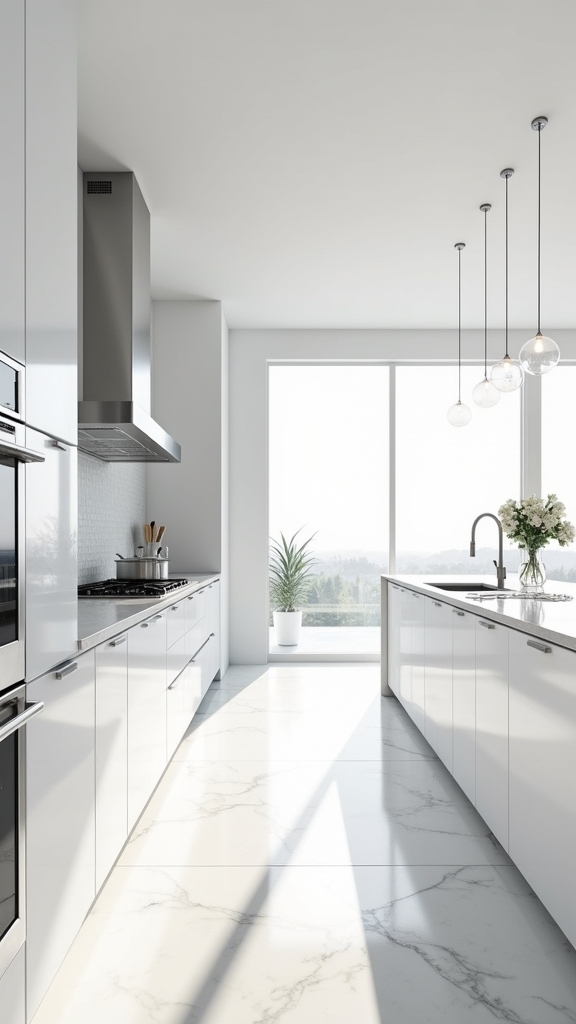
Illumination and spaciousness define the transformative power of white in kitchen design.
White cabinetry acts as a versatile canvas, amplifying ambient light and visually expanding even compact layouts. The strategic use of an all-white palette not only creates space but also introduces a seamless, contemporary visual flow that feels both clean and inviting.
Expert designers often recommend integrating open shelving painted in white to maintain openness and minimalism, while enabling effortless access and organization. The adaptability of white allows for subtle injections of personality through accent colors and textural contrasts.
- Maximizes light reflection for a brighter ambiance
- White cabinetry visually enlarges small kitchens
- Open white shelving sustains minimalist aesthetics
- White surfaces simplify the addition of accent colors
- Pairs well with wood and patterned tiles for balance
Incorporating brushed metal hardware can enhance the refined aesthetic of a white kitchen, introducing a modern touch that complements the bright and timeless design.
Team Concrete for Contemporary Cool
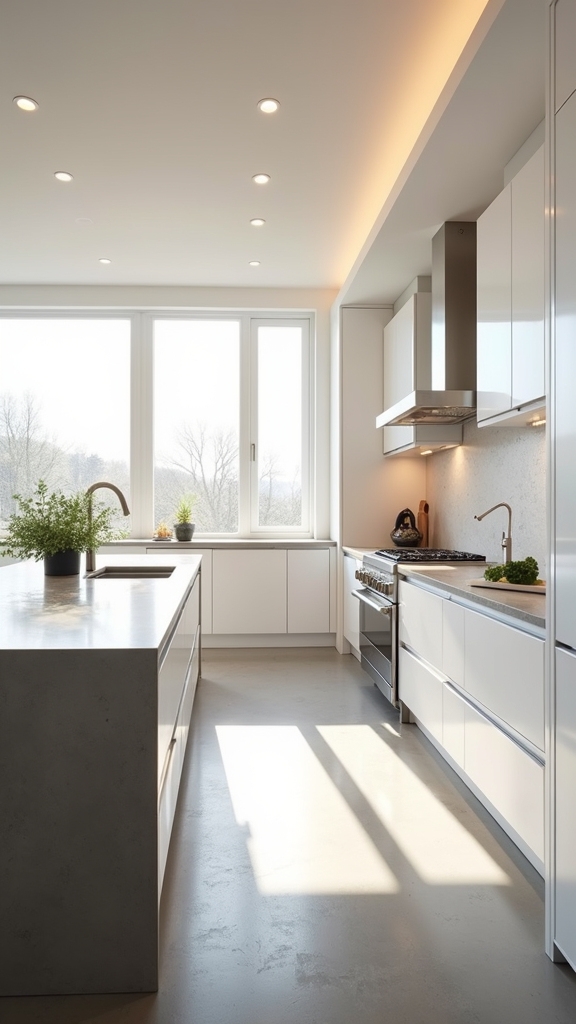
Building on the luminous foundation of white cabinetry, the integration of concrete surfaces infuses a kitchen with modern sophistication and tactile interest.
In the context of a modern kitchen, concrete countertops present a sleek, architectural profile that amplifies the clean lines and understated luxury of a contemporary white kitchen.
The versatility of concrete allows for varied finishes—polished, matte, or subtly textured—each offering a bespoke design solution that aligns with minimalist or industrial aesthetics.
This material’s durability and resilience to heat and scratches make it particularly suited to high-traffic culinary spaces.
Warm up White With Wooden Touches

By incorporating wooden elements into an all-white kitchen, designers introduce organic warmth and nuanced texture that counterbalance the crisp uniformity of white cabinetry.
Wooden touches—ranging from handcrafted shelving to solid wood countertops—infuse the environment with visual and tactile interest. Natural wood finishes, especially in warm or reclaimed varieties, offer a striking juxtaposition to pristine surfaces, softening the atmosphere while contributing to a sense of hospitality.
Warm wood accents bring inviting texture and visual depth, transforming all-white kitchens into spaces of comfort and hospitality.
These elements not only anchor the space aesthetically but also align with the growing emphasis on sustainability in modern interiors. As a focal point, a wooden kitchen island or accent wall can enhance the design, blending timeless sensibilities with contemporary appeal.
Consider these approaches for integrating wooden warmth:
- Solid wood countertops
- Reclaimed timber shelving
- Warm wood-tone kitchen islands
- Wooden drawer and cabinet pulls
- Natural finish ceiling beams
To create a dynamic space, consider mixing textures like wood, stone, and metal, which adds complexity and warmth to rustic kitchen designs.
Try Off-White for a Softer Look
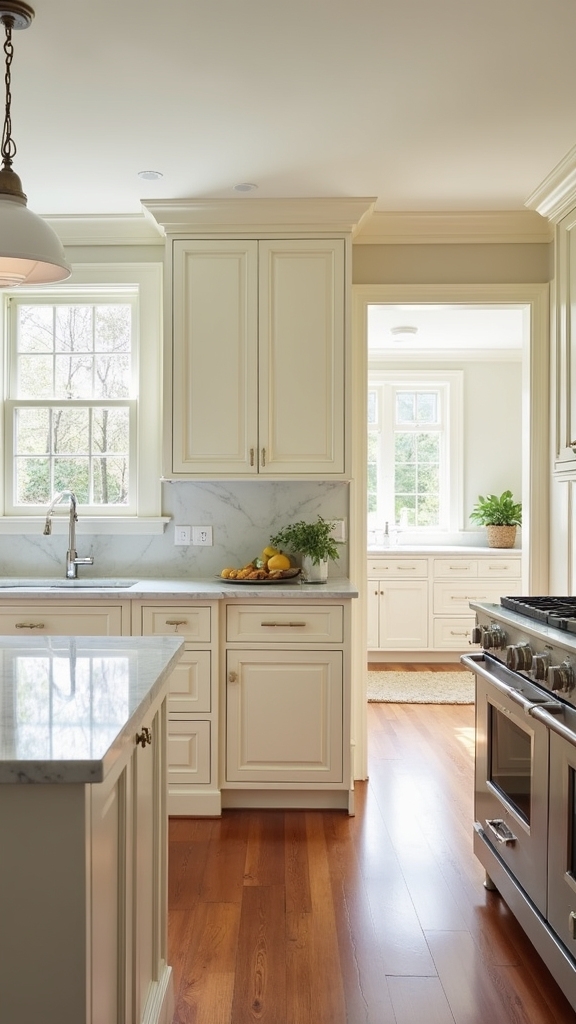
While wooden accents introduce warmth and dimension to a white kitchen, opting for off-white cabinetry offers a more nuanced approach to softness. Off-white shades impart a gentle warmth that pure, classic white often lacks, resulting in a welcoming and layered aesthetic.
This subtle variation harmonizes seamlessly with natural wood elements, elevating the sense of coziness and visual depth within the space. From a practical standpoint, off-white finishes are adept at camouflaging everyday smudges and fingerprints, making them a preferred choice for busy households seeking both elegance and ease of maintenance.
Off-white’s versatility also allows it to bridge traditional and contemporary kitchen designs, providing a timeless backdrop that enables colorful accents and decorative accessories to pop, without sacrificing the tranquil, sophisticated ambiance that classic white kitchens are known for.
Add a Splashback of Marvelous White Marble
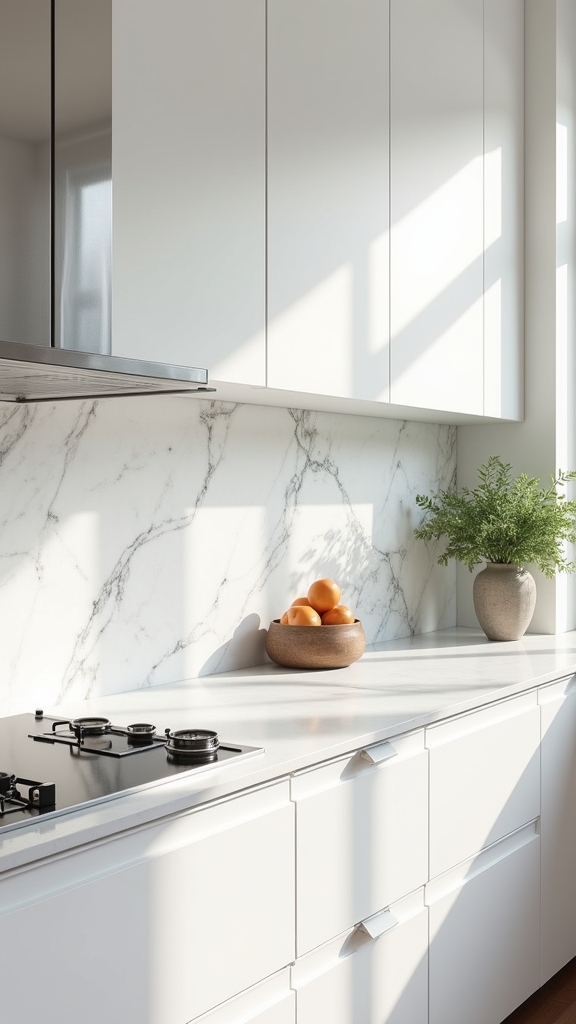
A white marble splashback instantly enhances a kitchen’s visual impact, with dramatic veining patterns introducing dynamic artistry against crisp cabinetry.
Designers frequently pair marble with flat-front or shaker-style cabinets to create a seamless yet striking interplay of textures.
To preserve marble’s pristine finish and luster, expert maintenance—including regular sealing and gentle cleaning—is essential for long-term durability.
Elevate With Veined Patterns
When seeking to infuse a white kitchen with refined sophistication, a marble splashback featuring distinctive veined patterns stands out as a premier choice.
The natural veining of white marble introduces visual intrigue while maintaining an understated elegance that enhances the entire space. These intricate patterns add depth and dimension, preventing the kitchen from appearing flat or sterile.
The luminous surface of marble further amplifies ambient light, contributing to a bright, inviting atmosphere. This design approach expertly balances trend-forward sensibility with enduring appeal.
- Highlights the veins as a focal point, showcasing natural artistry
- Adds depth without overwhelming minimalist white cabinetry
- Reflects light to enhance the kitchen’s brightness
- Delivers a timeless look compatible with evolving trends
- Offers exceptional durability, ideal for high-use splashback zones
Pairing Marble and Cabinets
Building upon the allure of veined marble, pairing white marble with white cabinetry achieves a seamless and luminous aesthetic that epitomizes modern kitchen sophistication. The radiant interplay of marble or quartz surfaces with sleek cabinetry will help amplify natural light, creating an open, airy environment. A full-height marble splashback unifies the vertical and horizontal planes, enhancing both visual cohesion and practical protection. Subtle veining in the marble introduces organic movement, preventing monotony and elevating the spatial dynamic. Whether in compact kitchens or expansive layouts, this combination delivers a timeless, gallery-like atmosphere prized in luxury design. The table below summarizes the visual and functional synergy of this pairing:
| Feature | Visual Benefit | Functional Strength |
|---|---|---|
| Marble Splashback | Depth and cohesion | Wall protection |
| White Cabinets | Seamless integration | Enhanced brightness |
| Veined Marble | Organic interest | Heat resistance |
| Reflective Surfaces | Amplifies light | Spacious feel |
Maintenance Tips for Longevity
Enhance the longevity of a white marble splashback by adhering to meticulous maintenance protocols that safeguard both its luminous finish and structural integrity.
The marble backsplash, renowned for its elegant veining and timeless appeal, demands targeted care to preserve its pristine character amidst daily kitchen activity.
Expert-endorsed maintenance tips guarantee this sophisticated feature remains unmarred by stains, scratches, or etching—sustaining the high-gloss allure that defines contemporary kitchen design.
- Use a pH-balanced, gentle cleaner to routinely wipe the marble backsplash, preventing residue buildup.
- Employ a soft cloth or sponge, avoiding abrasive tools that can scratch the marble’s surface.
- Apply a quality stone sealer every 6-12 months to bolster moisture and stain resistance.
- Promptly remove acidic spills to prevent etching and discoloration.
- Keep hot cookware off the marble to avoid thermal shock and cracking.
Make Your Appliances Match

A cohesive kitchen aesthetic often hinges on thoughtful appliance selection, with matching finishes amplifying the seamless appeal of white cabinetry.
Opting for white appliances allows them to blend effortlessly with white cabinetry, emphasizing a bright, expansive ambiance that reflects natural and artificial light.
For those seeking a contemporary edge, stainless steel or chrome appliances and accessories offer a sleek contrast while maintaining harmony with crisp white elements.
Integrated appliances, concealed behind custom cabinetry panels, achieve an uninterrupted visual flow—an ideal strategy for minimalist or modernist kitchen designs.
Alternatively, selecting appliances in muted tones or pastels can introduce nuanced color without disrupting the kitchen’s timeless allure.
Each option guarantees the kitchen remains visually unified, letting the cabinetry’s elegance and the appliances’ functionality coexist gracefully.
Jazz up White With Sunshine Yellow
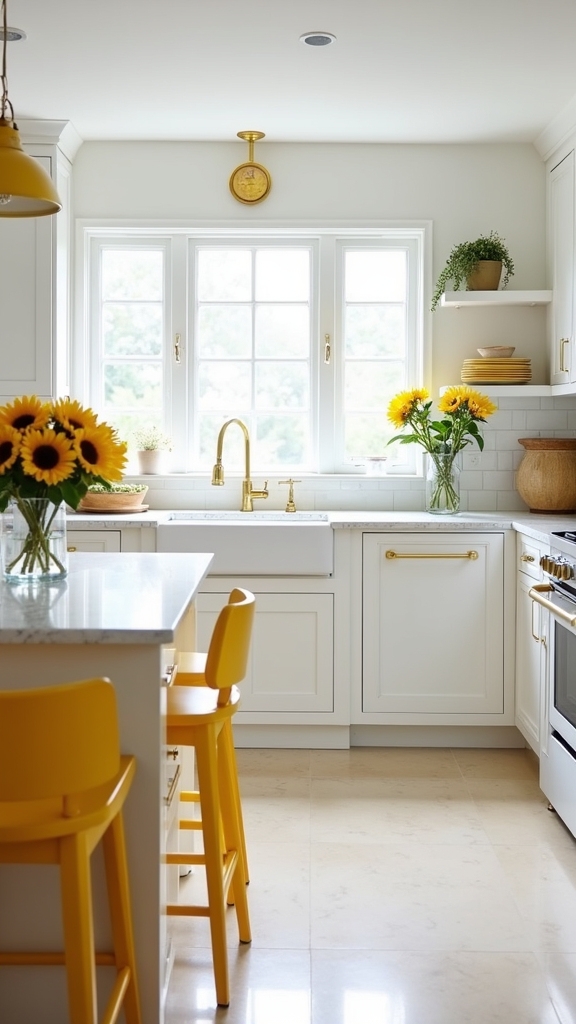
Sunshine yellow offers a dynamic counterpoint to white cabinetry, whether showcased through accent panels or bold hardware.
Designers increasingly specify yellow appliances as focal features, injecting energy and modernity into streamlined kitchen layouts.
Integrating yellow in decorative elements—such as pendant lights, bar stools, or patterned textiles—aligns with current trends favoring vibrant, optimistic interiors.
Accentuate Cabinets With Yellow
Vivid infusions of yellow provide a dynamic counterpoint to crisp white cabinetry, instantly invigorating the kitchen’s visual narrative.
Utilizing white cabinets as a neutral canvas, designers introduce sunshine yellow as a colour accent to foster an uplifting, airy environment. This technique is particularly effective in compact spaces, where reflective surfaces and bold hues maximize perceived scale.
The interplay of yellow against white cabinetry not only delivers a cheerful ambiance but also injects a contemporary edge and warmth into the design. For those seeking a timeless yet flexible palette, this pairing remains both relevant and easily adaptable.
- Highlight shelving with yellow dishware
- Install a yellow-tiled feature backsplash
- Display bold yellow artwork for visual interest
- Use yellow barstools or seating elements
- Paint a single accent wall in a soft yellow shade
Yellow Appliances for Pop
Statement-making appliances in radiant yellow instantly energize a white kitchen, establishing a contemporary focal point amidst the neutral palette.
The integration of yellow appliances against sleek white cabinetry exemplifies a design-forward approach, channeling both vibrancy and sophistication. This juxtaposition highlights the crisp geometry of the cabinetry while infusing the space with warmth and positivity—characteristics enhanced by the psychological impact of yellow.
Designers increasingly favor this playful yet controlled use of bold color, reflecting a broader trend toward expressive, personality-driven interiors. Yellow appliances become functional art, animating the kitchen without overpowering its clean lines.
Additionally, this color pairing offers versatility; as trends evolve, accent details can be effortlessly updated, while the yellow appliances maintain their cheerful allure, ensuring the kitchen remains both current and inviting.
Sunshine Hues in Decor
When strategically integrated, sunshine yellow accents introduce a vibrant counterpoint to the crisp minimalism of a white kitchen, elevating both visual interest and spatial luminosity.
Sunshine hues, applied with discernment, transform the kitchen into a welcoming, energetic environment without overpowering the timeless elegance of white cabinetry and surfaces.
The trend of layering yellow decor elements with pristine white backgrounds amplifies natural light, enhancing the room’s sense of airiness and warmth.
Designers recommend measured applications for maximum impact and cohesion.
Consider these expert strategies to incorporate sunshine hues in a white kitchen:
- Yellow dishware displayed on open shelving for visual pop
- Sunshine yellow bar stools or island seating
- Painted yellow backsplash as a statement zone
- Kitchen towels and textiles in bright yellow patterns
- Decorative accessories, such as vases or wall art, in sunny tones
Fill a Large Space With White
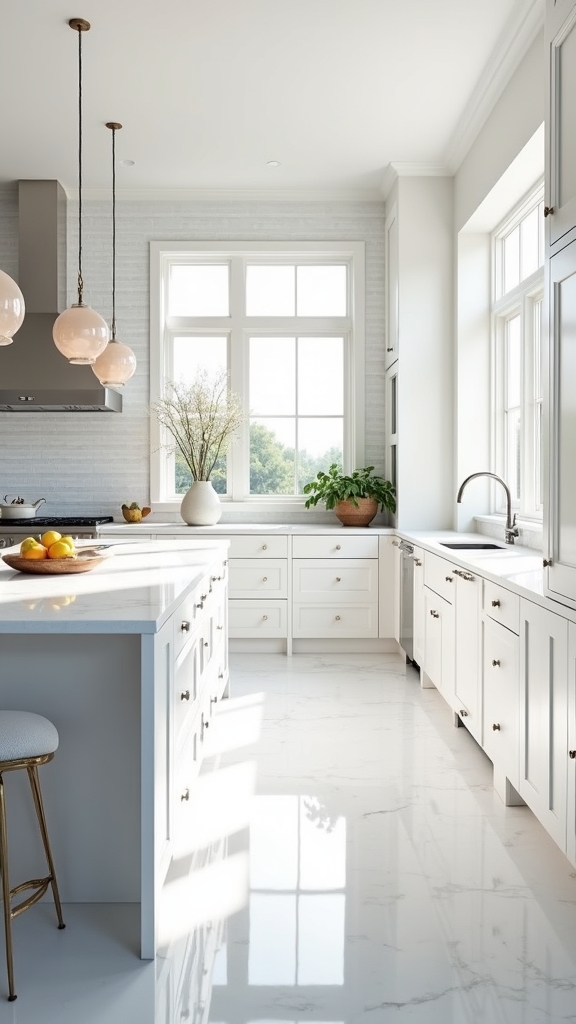
Expansive kitchens benefit from the strategic application of white, as continuous white cabinetry and walls establish a seamless, airy envelope that amplifies the perception of volume.
The reflective properties of white surfaces optimize both natural and artificial illumination, ensuring the space feels bright and welcoming—even in areas with limited daylight.
To maintain cohesion while maximizing storage, designers often employ open shelving painted white, allowing functional elements to blend harmoniously within the architectural context.
To avoid sterility, integrating warm wood accents or tactile textiles introduces visual warmth and depth, a critical consideration in contemporary kitchen trends.
For added dimension without overwhelming the design, high-contrast statements, such as a charcoal island or a vibrant backsplash, punctuate the expanse, subtly delineating zones within the large white-dominated space.
Find Space for a Breakfast Bar
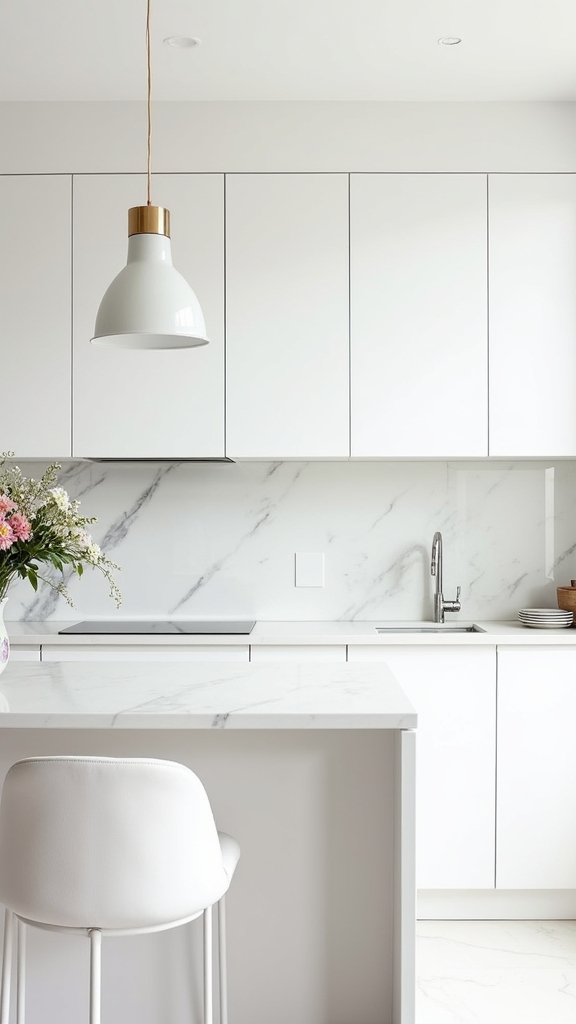
How can a white kitchen achieve both seamless design and everyday practicality? Integrating a breakfast bar is a strategic solution, maximizing underutilized counter space and fostering a dynamic hub for daily life.
In contemporary white kitchens, the breakfast bar serves as both a functional prep area and an inviting spot for casual dining or socializing. Expert design merges sleek, white cabinetry with matching countertops, ensuring the breakfast bar blends harmoniously into the overall aesthetic.
Attention to detail—such as open shelving above—elevates accessibility and visual interest. For a refined yet lively atmosphere, consider these elements:
Open shelving above the breakfast bar adds both ease of access and a touch of visual intrigue to your white kitchen design.
- Utilize streamlined white cabinetry for continuity
- Incorporate open shelving for accessible storage
- Position the breakfast bar for ideal traffic flow
- Select comfortable, stylish bar stools
- Emphasize minimalist hardware to maintain cohesion
Dress White Kitchens With Colourful Accessories
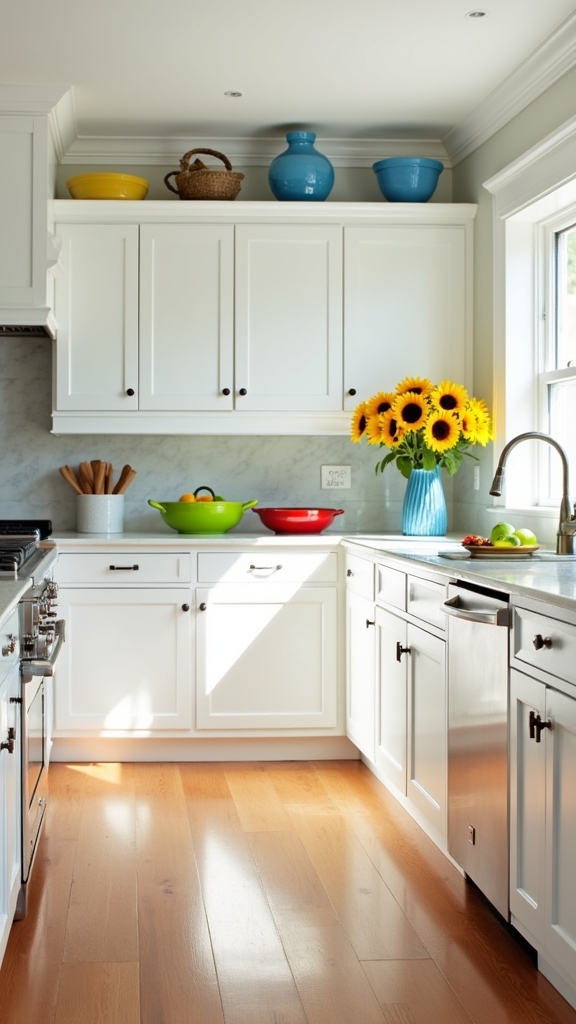
While a thoughtfully integrated breakfast bar enhances a white kitchen’s functionality, introducing colorful accessories infuses the space with character and visual energy.
The strategic placement of vibrant plates, contemporary artwork, or sculptural vases can punctuate the monochrome backdrop, creating dynamic focal points. Designers often recommend textiles—such as bold dish towels, patterned window treatments, or graphic seat cushions—to deliver warmth and a tactile layer, further softening the crisp aesthetic of a white kitchen.
Seasonal colorful accessories offer flexibility, enabling effortless updates that reflect current trends or personal preferences without committing to permanent change. Incorporating verdant plants and vivid kitchen tools maximizes both vibrancy and practicality.
Whether opting for strong primaries or nuanced tonal hues, these elements introduce contrast and dimension, keeping white kitchens visually engaging and thoroughly current.
Frequently Asked Questions
How to Design a Timeless White Kitchen?
Designing a timeless white kitchen involves prioritizing a functional kitchen layout, selecting enduring countertop materials like quartz or marble, and layering visual interest with mixed textures, elegant fixtures, and strategic storage to maintain a bright, cohesive aesthetic.
What Is the Best Color for a Timeless Kitchen?
The best color for a timeless kitchen is found in neutral color palettes, such as crisp whites or soft greys. These hues complement classic kitchen features, ensuring enduring appeal, adaptability to evolving trends, and visually enhancing brightness and spaciousness.
Is a White Kitchen Timeless?
The question of whether a white kitchen is timeless is routinely affirmed by industry experts. White kitchen trends consistently integrate classic designs, offering enduring visual appeal, adaptability to evolving aesthetics, and maximizing spatial luminosity for a perpetually fresh, sophisticated atmosphere.
What Color Is Best for a White Kitchen?
Ideal kitchen color psychology emphasizes contrast and visual interest; current white kitchen trends favor navy blue or emerald green accents for sophistication, while soft greys or taupes add warmth. Bold backsplashes or islands serve as dynamic, visually arresting focal points.
Conclusion
A white kitchen remains a quintessential choice for its luminosity, adaptability, and enduring appeal. Modern trends enhance this classic palette through textural contrasts—matte cabinetry, marble veining, and artisanal tiles—while pops of color and bold flooring ground the aesthetic. Open shelving and integrated breakfast bars optimize both function and flow. Whether layered with contemporary accents or vibrant accessories, these expert-approved white kitchen ideas guarantee a timeless, visually compelling space that evolves seamlessly with changing design sensibilities.
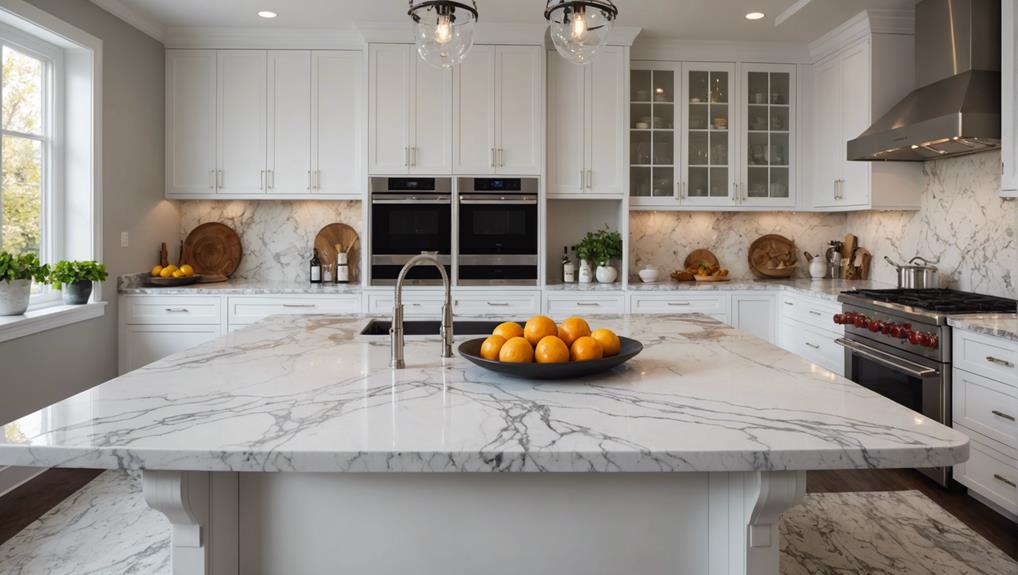
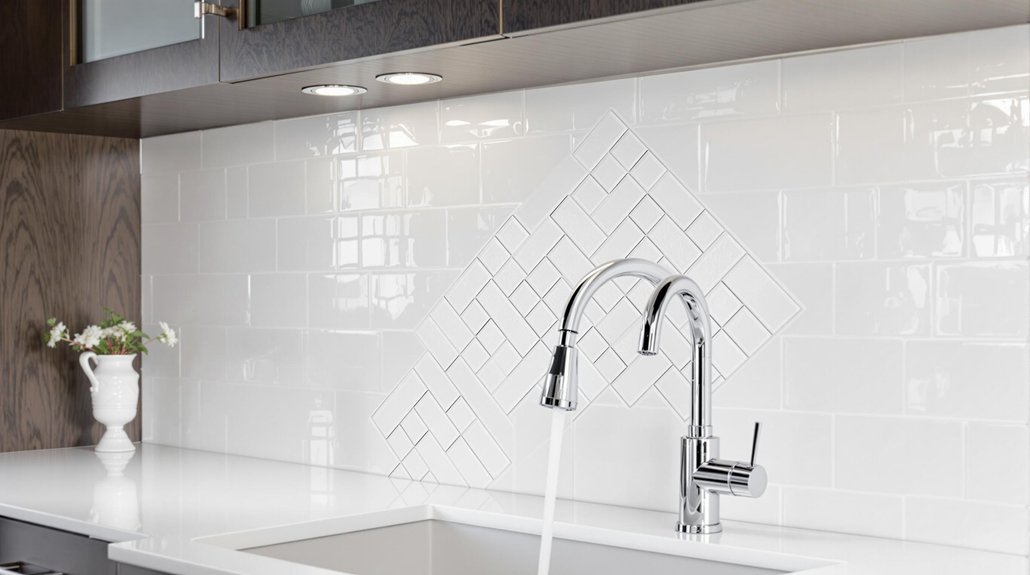
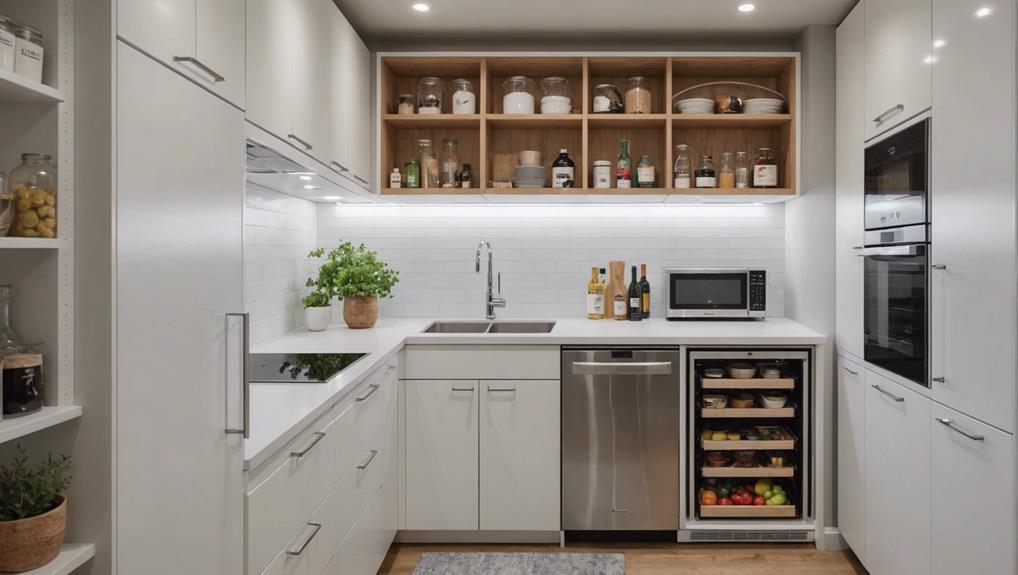
Leave a Reply